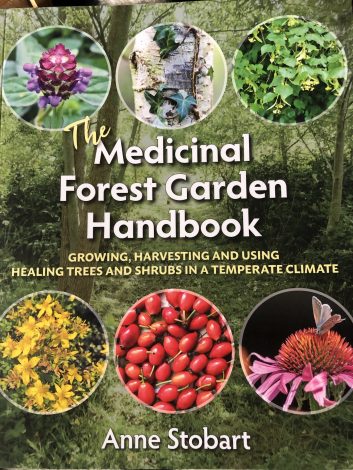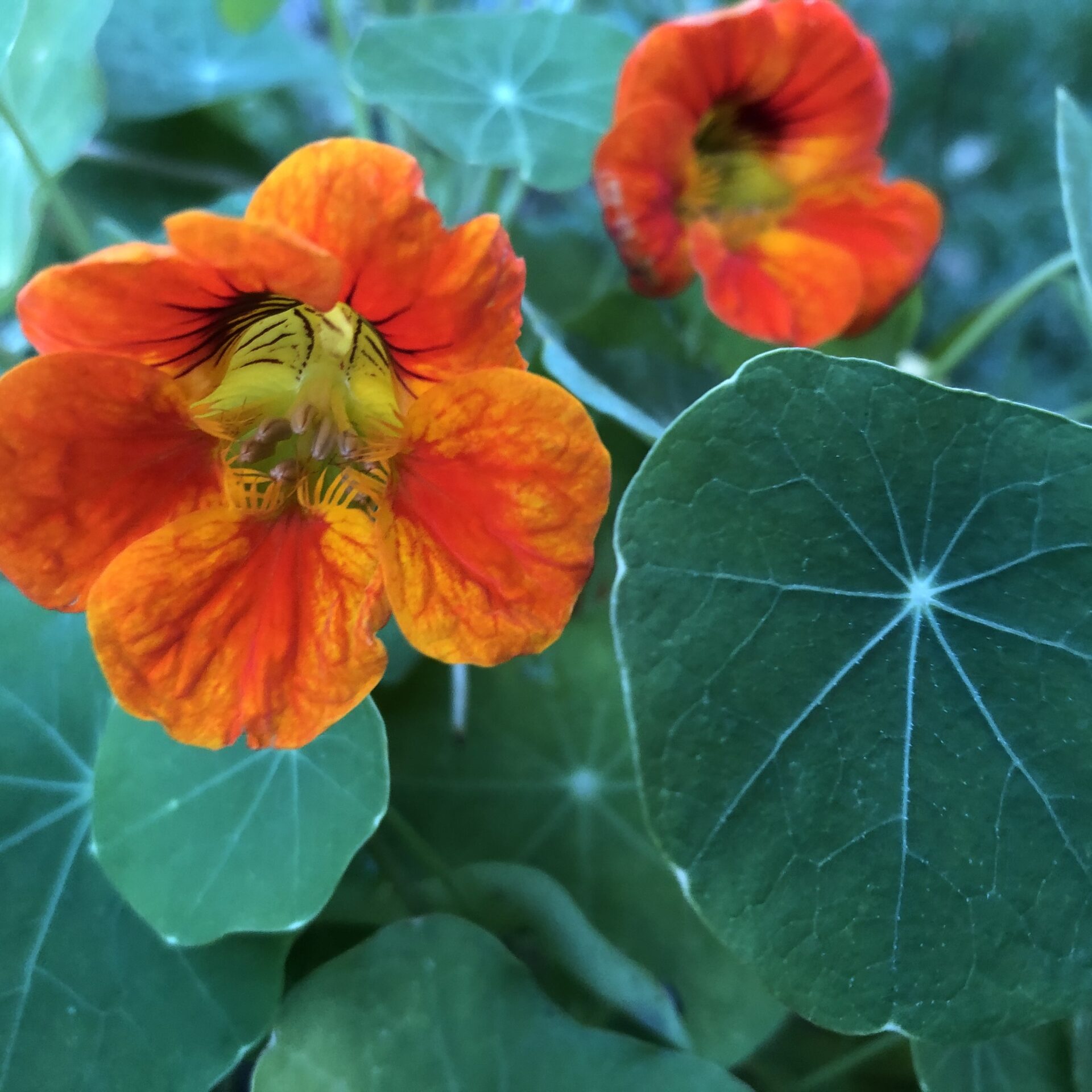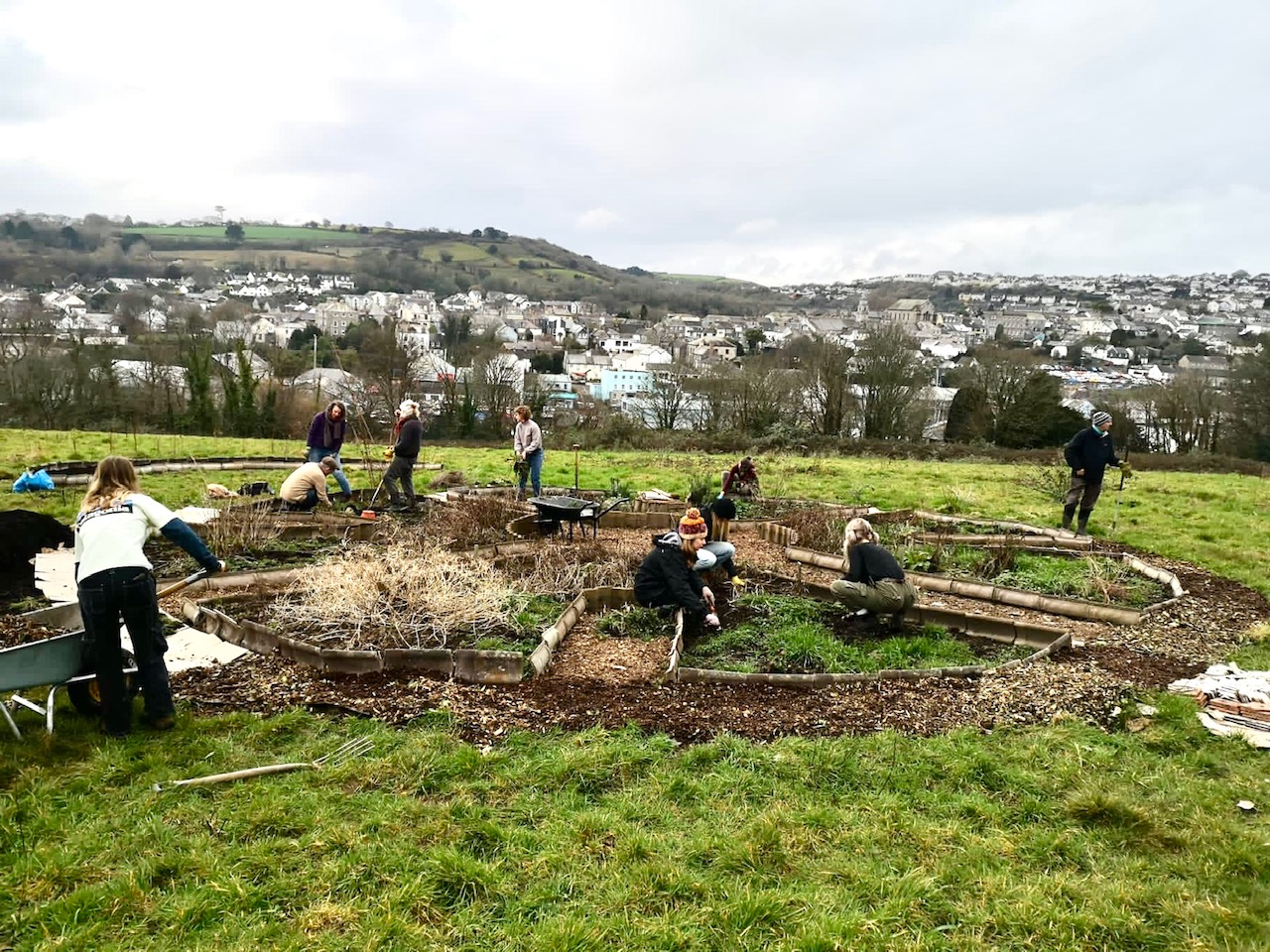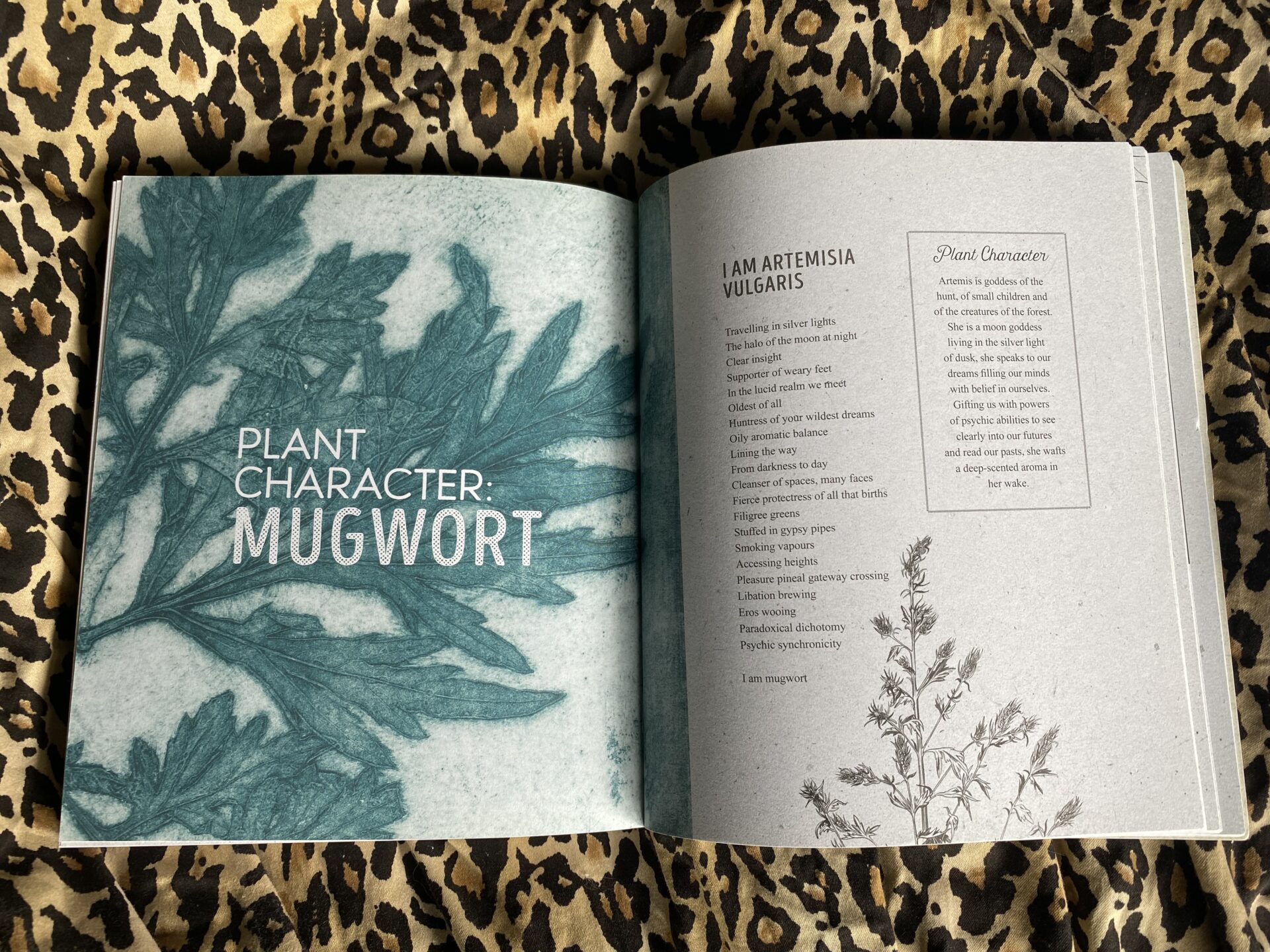Us Seed SistAs met at Middlesex University where we were studying a 4 year BSc degree in phytotherapy. On the first year in the first term of that degree we had a module called History of Herbalism taught by Anne Stobart. She was a wonderful supportive tutor and is an experienced and extremely well studied Herbalist with a wealth of knowledge here she tells us a little about her Forest Garden and it’s medicine.
Many decades ago I began wondering about where my herbal supplies came from. As a newly qualified herbal practitioner in the 1990s I had a dispensary with over 120 herbal tinctures and teas on the shelves. But when I looked closely at the labels I could see that many herbs had started life far away – in Eastern Europe, Asia or USA. My thoughts began to formulate then, about growing more medicinal herbs at home, especially herbs for women’s conditions. What would be possible? I had already grown some herbs on my allotment, like Comfrey and St John’s wort, Feverfew and Marigold for fresh infused oils or alcohol tinctures. But I wanted to grow more, not only leafy plants and flowers but also bark and berries from healing shrubs and trees like Cramp Bark and Chasteberry. Sadly, my allotment rules did not allow flexibility for planting of trees. With very little space in our tiny cottage garden in Devon, I had to start thinking about finding a piece of land for tree planting.
Buying a woodland
Fast-forward several decades and my partner and I had the opportunity to buy several acres of conifer plantation in Devon. We visited the location and were overwhelmed with the potential of the site, a gently sloping hillside facing southwest and near the River Torridge. Walking through the gloomy trees, we became enthused with the possibility of making space for more planting. The conifers were mainly Sitka Spruce, about 40 years old, and cast plenty of shade but we imagined that they might be gradually felled to create clearings for replanting. So we bought the woodland, known as Holt Wood, in 2004 as complete forestry novices. With a lot of help from wellwishers and volunteers, we eventually had the site cleared, fenced to keep out deer, and replanted with our own selection of medicinal trees. Since then we have been learning about how to sustainably cultivate and harvest medicinal trees and shrubs. There is more about our story and the herb courses we offer at www.holtwoodherbs.com.
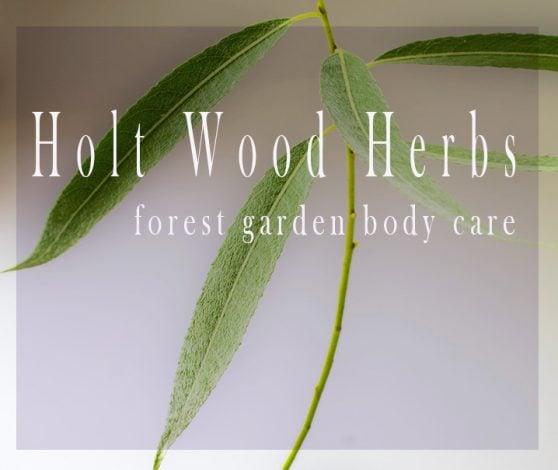
Holt Wood Herbs forest garden body care
Medicinal forest garden
Now, some 15 years later, we have a vibrant medicinal forest garden at Holt Wood. A few lovely conifers remain, and there is a glorious mix of native and introduced trees and shrubs, providing bountiful harvests of bark, flowers, fruit and leaves. Some of these plants are used as herbal remedies, while others have become key ingredients in our bodycare products which we sell online. Our original planting plan was based on permaculture design principles – creating zones with broad rides and edges to allow for multiple layers of plants. The planting plan has worked well, and many more useful plants have arrived without our help. We were able to develop further elements of the medicinal forest garden by using resources found on site such as stones for creating a track, and clay for puddling a pond. We have also established open beds for flowers and plants that need a bit more TLC (tender loving care) and light, and created a small nursery area to grow plants for sale on our herb courses.
Variety of soils and growing conditions
Holt Wood is recognised as a LAND permaculture project, part of a network of demonstration permaculture projects, and it appears to be the only forest garden which predominantly focuses on medicinal herbs. One of the best things about our woodland site is the range of soil conditions, varying from dry stony slope to poor claggy soils to deep forest floor leaf litter and acid soil. There is a very soggy meadow area, which is perfect for growing White and Violet Willow (Salix alba and S. daphnoides). Around the meadow area are the Cramp Bark (Viburnum opulus) trees which like a moist location but not standing in water all year. On higher ground we have some Chinese Maidenhair (Ginkgo biloba) trees establishing, as well as Prickly Ash (Zanthoxylum americanum), and many others. Our harvesting approach is based on coppicing, pollarding and pruning to ensure continuing sustainable harvests.
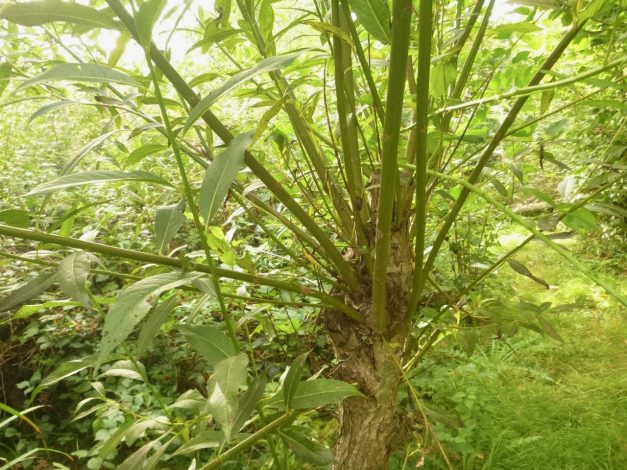
White willow (Salix alba) grows vigorous new stems after pollarding
Dealing with period pains
As the name suggests, Cramp Bark is an excellent remedy for painful cramps, especially period pains. We have found that it can be readily coppiced by cutting to the ground in the winter period. It throws up fresh canes which are harvested every other year for the antispasmodic bark. This bark is peeled off just as the leaves open and it can be chopped and dried, then ground to powder for capsules or used in a percolated alcohol extract. Our Cramp Bark is an ingredient in the lovely Moontime Chocolates created for women by a neighbourhood friend (https://www.moontimechocolate.co.uk).
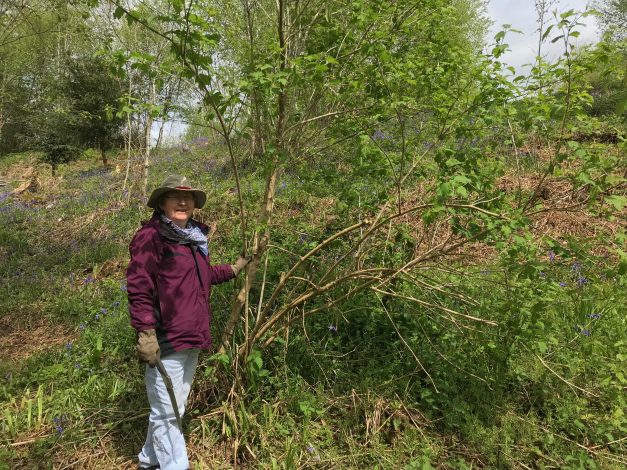
The author harvesting a coppiced cramp bark (Viburnum opulus) tree
Toning up the reproductive system
Right from the beginning of replanting Holt Wood we noticed lots of native wildflowers and other plants. There is lots of Wild Strawberry (Fragaria vesca) carpeting one area, and in another part we find Raspberry (Rubus idaeus) growing wild. This latter plant enjoys wet shady parts and provides us with young fresh leaves to dry for supporting the female reproductive system. The astringency of this herb as an infusion is ideal for problem periods, and it is traditionally taken in the last trimester of pregnancy to help tone uterine muscle.
Balancing hormones
A rather more exotic introduction in our woodland is Chasteberry (Vitex agnus castus) which can establish well in a sheltered area but needs plenty of light and water. We have seen it growing wild on a sandy Turkish beach and this gives an indication of its need for warmth and good drainage. This gorgeously aromatic shrub has an interesting effect on the body, generally regarded as progesterone-like. So it can be used in conditions where the effects of oestrogen are unbalanced, such as premenstrual and menopausal complaints. Although the berries are often prescribed, these are not readily produced in the UK and I have found that the aromatic foliage and young stems are almost as good for making a tincture.
Dealing with urinary complaints
So many plants could be mentioned, but one rather unexpected wild flower has appeared in the woodland which is a good remedy for urinary complaints – this is Goldenrod (Solidago virgaurea). It is a tall yellow-flowered member of the daisy family which likes a dry woodland location. This is the native UK species, rather than the larger North American Goldenrod (Solidago canadensis). The dried flowers and leaves can be used in a tea or tincture for urinary complaints like cystitis as well as other mucosal problems such as a sore throat.
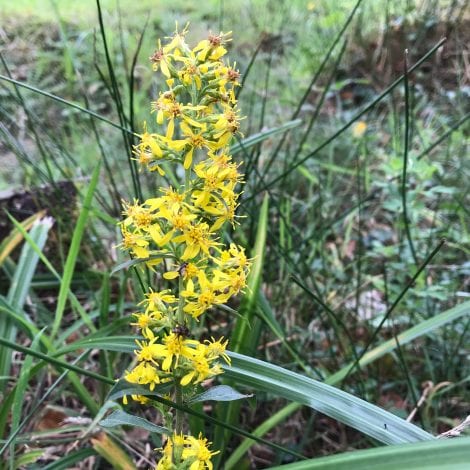
Goldenrod (Solidago virgaurea) is a plant of dry woodland
Improving circulation
Last but not least, the Nettle (Urtica dioica) grows freely in moister parts of our woodland where the soil is richer and nutritionally better supplied from the overflowing meadow. This plant is an important source of mineral constituents, helping to restore blood lost in menstruation or to support milk production in breastfeeding. The benefits of Nettle extend in other ways too, for use as a diuretic and anti-inflammatory. This herb is very adaptable and can be taken as a soup, tea or tincture.
Forest garden bodycare products
While I have highlighted five plants above which can have an important role in women’s conditions, there are many other herbs from our forest garden which are used medicinally. We also use the plants in bodycare products sold to help defray our costs and support the demonstration project. For example, we harvest and dry Willow bark to include it as a powder in several handmade soaps. The powdered Willow bark acts as an effective exfoliant for the skin, and is great for spots and acne. We also grow the North American Witch Hazel (Hamamelis virginiana) shrub using the leafy twigs which are distilled to an astringent water used for skin cleansing and first aid, another remedy ideal for spotty skin. And our distilled Witch Hazel works well mixed with our distilled Rosemary water to make a natural aromatic deodorant spray. We avoid synthetic preservatives, and all of our bodycare items are made in small batches.
Teaching others about growing medicinal trees
For several years we have run a range of day courses at Holt Wood so that people can come and learn all about medicinal trees and shrubs. The feedback has been so positive that we will be running several weekend courses, either on 23/24 May 2020 or 20/21 June 2020, all about designing a medicinal forest garden, harvesting and using the healing plants. The weekend course will bring together the best elements of our one-day courses on designing, harvesting and historical herbs. Course participants will have the opportunity to take a guided walk around Holt Wood and see the wide range of plants that we grow. Practical sessions will be offered in harvesting medicinal plants including bark, and making a variety of herbal remedies from poultices to tinctures. The courses are based on a small group so there is plenty of opportunity to discuss particular interests. Further details of courses and booking are available at www.holtwoodherbs.com
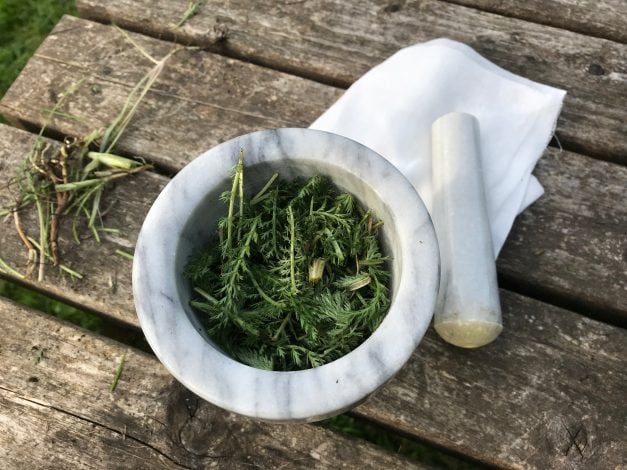
Poultice-making on a Holt Wood course
Biography
Anne Stobart is a consultant medical herbalist based in Devon. Until 2010, Anne was Programme Manager for the professional degree programme in herbal medicine at Middlesex University in London. Anne co-founded the Holt Wood Herbs project (www.holtwoodherbs.com) in Devon to develop sustainable ways of cultivating and harvesting medicinal trees and shrubs. She has written about the history of herbal medicine and has published her historical research in Household Medicine in Seventeenth-Century England (Bloomsbury Academic, 2016). Anne’s latest book is The Medicinal Forest Garden Handbook (Permanent Publications, March 2020).
